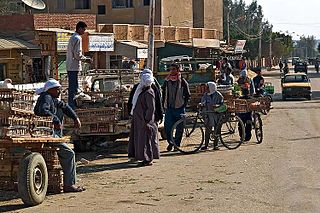 W
WEl-Wahat el-Bahariya or el-Bahariya is a depression and oasis in the Western Desert of Egypt. It is approximately 370 km away from Cairo. The roughly oval valley extends from northeast to southwest, has a length of 94 km, a maximum width of 42 km and covers an area of about 2000 km².
 W
WBaris is an oasis in Egypt. It contains the ancient Egyptian temple of Dosh.
 W
WDakhla Oasis, translates to the inner oasis, is one of the seven oases of Egypt's Western Desert. Dakhla Oasis lies in the New Valley Governorate, 350 km (220 mi.) from the Nile and between the oases of Farafra and Kharga. It measures approximately 80 km (50 mi) from east to west and 25 km (16 mi) from north to south.
 W
WThe Faiyum Oasis is a depression or basin in the desert immediately to the west of the Nile south of Cairo in Egypt. The extent of the basin area is estimated at between 1,270 km2 (490 mi2) and 1700 km2 (656 mi2). The basin floor comprises fields watered by a channel of the Nile, the Bahr Yussef, as it drains into a desert hollow to the west of the Nile Valley. The Bahr Yussef veers west through a narrow neck of land north of Ihnasya, between the archaeological sites of El Lahun and Gurob near Hawara; it then branches out, providing rich agricultural land in the Faiyum basin, draining into the large saltwater Lake Moeris. The lake was freshwater in prehistory but is today a saltwater lake. It is a source for tilapia and other fish for the local area.
 W
WThe Farafra depression is a 980 km2 (380 sq mi) geological depression, the second biggest by size in Western Egypt and the smallest by population, near latitude 27.06° north and longitude 27.97° east. It is in the large Western Desert of Egypt, approximately midway between Dakhla and Bahariya oases.
 W
WThe Kharga Oasis "the outer"; Coptic: (ϯ)ⲟⲩⲁϩ `ⲛϩⲏⲃ, (ϯ)ⲟⲩⲁϩ `ⲙⲯⲟⲓ (Di)Wah Ēnhib, "Oasis of Hib", (Di)Wah Ēmpsoy, "Oasis of Psoi") is the southernmost of Egypt's five western oases. It is located in the Western Desert, about 200 km to the west of the Nile valley. "Kharga" or "El Kharga" is also the name of a major town located in the oasis, the capital of New Valley Governorate. The oasis, which was known as the 'Southern Oasis' to the Ancient Egyptians and Oasis Magna to the Romans, is the largest of the oases in the Libyan desert of Egypt. It is in a depression about 160 km long and from 20 km to 80 km wide. Its population is 67,700 (2012).
 W
WThe Qara Oasis is one of the inhabited oases of Egypt, with a population of 363 Berbers, though of a darker complexion than the inhabitants of the Siwa Oasis. This oasis is often disregarded when it comes to counting the number of Egyptian oases as it is very small compared to the others. In local folklore, if a newborn arrives, an elder will die shortly after, thus keeping the population constant. It lies at the northwest edge of the Qattara Depression, 75 km northeast of Siwa Oasis, and belongs to Siwa District within Matrouh Governorate and is connected to the Matruh-Siwa road by an asphalted access route. Originally, the inhabitants lived atop a neighbouring mountain which acted as a natural fortress, but today they live in simple houses beneath. Electricity for street lighting and houses is provided by small individual solar cells.
 W
WThe Siwa Oasis is an urban oasis in Egypt between the Qattara Depression and the Great Sand Sea in the Western Desert, 50 km (30 mi) east of the Libyan border, and 560 km (348 mi) from Cairo. About 80 km (50 mi) in length and 20 km (12 mi) wide, Siwa Oasis is one of Egypt's most isolated settlements with about 33,000 people, mostly Berbers, who developed a unique and isolated desert culture and a distinct dialect and language different than all other languages in Egypt called Siwi; they are also fluent in the Egyptian dialect of Arabic which is called "Masry" meaning Egyptian.